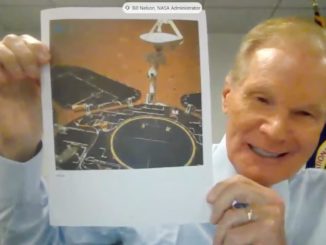
Nearly halfway through its primary mission, South Korea’s first spacecraft to explore the moon has been collecting data and snapping pictures of lunar landscapes and craters since maneuvering into orbit late last year.
South Korea’s Danuri spacecraft, flying about 60 miles (100 kilometers) over the lunar surface, is regularly capturing views of the moon and beaming the imagery back to Earth for analysis by scientists. The spacecraft entered orbit around the moon last December, about four months following its launch aboard a SpaceX Falcon 9 rocket from Cape Canaveral.
Danuri, also called the Korea Pathfinder Lunar Orbiter, made South Korea the eighth country or space agency to place a spacecraft into orbit around the moon.
The Korean lunar orbiter carries six scientific instruments and technology demonstration payloads. The spacecraft’s Lunar Terrain Imager, or LUTI, instrument took the pictures included in the most recent image release from the Korea Aerospace Research Institute.
The black-and-white images, released last month, show several locations on the far side of the moon.
One of the views is centered on the central peak inside Tsiolkovskiy crater, an approximately 115-mile-wide (185-kilometer) basin carved by an ancient impact more than 3.5 billion years ago. The mountain rises more than 11,000 feet (3,400 meters) over the crater floor.

“Detailed shapes such as craters on the lunar surface and towering peaks within the craters can be clearly identified (in Danuri’s images),” the Korea Aerospace Research Institute said in a statement. “Such high-resolution images can be used as important data for understanding the components of the lunar surface and the formation process of peaks in craters in the future.”
Other images from South Korea’s Danuri spacecraft shows the regions of Vallis Schrödinger and Szilard crater, also located on the moon’s far side.
The name Danuri is a combination of the words “dal” and “nurida” in Korean, meaning “enjoy the moon.”
The mission’s scientific objectives include mapping the lunar surface to help select future landing sites, surveying resources like water ice on the moon, and probing the radiation environment near the moon. The Danuri mission cost about $180 million to develop, built, and launch, according to KARI.
The South Korean lunar orbiter is designed for a one-year primary mission, which officially started in January. Full science results from the mission will be released beginning in January 2024. If the orbiter has enough fuel remaining, mission managers could consider an extended mission starting next year.
One of the payloads on the KPLO, or Danuri, mission is a U.S.-built instrument named ShadowCam.
Derived from the main camera on NASA’s Lunar Reconnaissance Orbiter, ShadowCam will peer inside dark craters near the moon’s poles, where previous missions detected evidence of water ice deposits. The NASA-funded ShadowCam instrument is hundreds of times more sensitive than LRO’s camera, allowing it to collect high-resolution, high signal-to-noise imagery of the insides of always-dark craters using reflected light.

Besides the Lunar Terrain Imager and the ShadowCam instruments, the Danuri spacecraft also carries a Wide-Angle Polarimetric Camera, a magnetometer to measure the magnetic field around the moon, a gamma ray spectrometer to study the composition of the lunar surface, and a tech demo payload to test “interplanetary internet” connection using a disruption tolerant network.
The Danuri mission is a pathfinder, or precursor, for South Korea’s future ambitions in space exploration, which include a robotic landing on the moon in the early 2030s. South Korea has also signed up to join the NASA-led Artemis Accords, and could contribute to the U.S. space agency’s human lunar exploration program.
Danuri’s exploration of the moon comes as a growing wave of robotic missions head for Earth’s nearest celestial companion. Last month, a privately-funded lander developed by a Japanese company called ispace crashed during descent to the lunar surface. Earlier this month, NASA gave up on trying to recover a small spacecraft called Lunar Flashlight that suffered from propulsion problems, preventing it from completing a scientific mission intended to study water ice inside craters at the moon’s south pole.
NASA’s CAPSTONE spacecraft, another relatively low-cost mission, entered orbit around the moon last November to perform navigation and communications technology demonstrations for future Artemis missions. NASA said earlier this month CAPSTONE completed its primary mission experiments, but will continue operating for additional tests in an extended mission phase.

NASA’s Artemis 1 test flight flew around the moon late last year with a human-rated Orion spacecraft, paving the way for Artemis 2 to launch as soon as late 2024 to carry a crew of four astronauts around the moon and back to Earth, the first piloted lunar mission since 1972.
More lunar missions are scheduled for launch later this year. Two robotic commercial lunar landers developed by Astrobotic and Intuitive Machines are slated to lift off in the coming months to deliver NASA science experiments to the lunar surface. The Astrobotic and Intuitive Machines missions are the first two flights to the moon under NASA’s Commercial Lunar Payload Services, or CLPS, program, in which NASA purchases transportation services to the moon from U.S. companies for scientific and tech demo payloads.
Email the author.
Follow Stephen Clark on Twitter: @StephenClark1.



